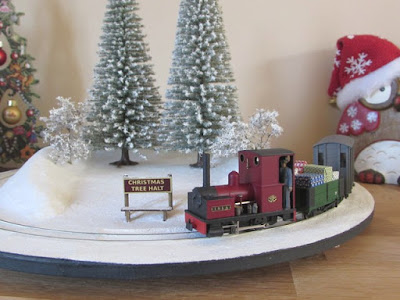With the end of 2020 in sight the O9 Keef has had a few jobs completed on it and to all intents and purposes is considered "complete" enough to be sat in the display case. Since the last set of photographs I have added (and weathered) glazing, lightly weathered the loco and fitted MicroTrains couplers. These were the first set of couplers I had assembled for some time, I had forgotten what I was missing out on...!
Railway modelling in 7mm scale on 9mm gauge track, representing 15" gauge miniature railways and 18" gauge industrial railways. (Plus anything else that I choose to include!)
Thursday 31 December 2020
2020 Hindsight
Tuesday 22 December 2020
Alan Keef K12 in O9 - Everythings Gone Green...
The green is Halfords 'Meadow Green', but you might have guessed that! Black and red areas were brush painted, red first over red oxide primer and then the green and red were masked off for the black to be painted.
Wednesday 16 December 2020
Christmas Tree Halt
Saturday 21 November 2020
Alan Keef K12 in O9 - 3D Print Manipulation
Saturday 7 November 2020
Alan Keef K12 in O9 - Take 2
Sunday 1 November 2020
Humberston - 009 Micro Diorama
I never saw the LCLR at Humberston. Last weekend I drove past the station site and you would never know that it was ever there, under the sprawl of the current caravan park. To find out more, I always commend a visit to the LCLR Pages on Dave Enefer's Website.
Friday 30 October 2020
The Road to Humberston
Earlier in October I completed the paintwork on my 009 LCLR Simplex 'Wilton'. Citadel 'Lothern Blue for the main bodywork, which had 4 slightly-thinned coats; Vallejo red on the bufferbeams, and a slightly lightened black on the frames, all hand-painted. Humbrol matt acrylic aerosol varnish has done a reasonable job of hiding the brush marks.
Sunday 4 October 2020
A Tale of Hinge Envy
Earlier in the year, before the world of lockdown, my thoughts turned to rolling stock for a future O9 project. Whilst some existing wagons could be used, more would be required if I went down a light industrial or agricultural route. In my analysis, my usual way of wagon building had three points of time consumption:
- Scribing plank lines on styrene sheet
- Creating wood grain effects
- Adding bolt detail individually
The chance purchase of a Slaters sheet of rivet details on 20 thou styrene sheet prompted some experimentation. Using this and Slaters planked sheet the wagon body on the left was built, eliminating all three points of contention... However, it looked more like a wagon built from shed timber than planks! So the Mk2 version on the right returned to scribed planks on the sides (but retaining the Slaters sheet on the floor).
Sunday 27 September 2020
'Wilton' - the 009 Simplex of deception
 |
















































